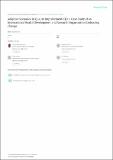| dc.contributor.author | Majigo, Mtebe | |
| dc.contributor.author | Oruko, Happiness | |
| dc.contributor.author | Kinagwi, Koki | |
| dc.contributor.author | Peter, Memiah | |
| dc.contributor.author | Gabriel, Mahasi | |
| dc.contributor.author | Fransesca, Odhiambo | |
| dc.contributor.author | Margaret, Mungai | |
| dc.contributor.author | Peter, Ofware | |
| dc.contributor.author | George, Kimathi | |
| dc.contributor.author | Janepher, Rugutt | |
| dc.contributor.author | Mwita, Nzomo | |
| dc.contributor.author | Meshack, Ndirangu | |
| dc.contributor.author | Lennie, Kyomuhangi | |
| dc.contributor.author | Samuel, Muhula | |
| dc.date.accessioned | 2021-12-09T22:31:47Z | |
| dc.date.available | 2021-12-09T22:31:47Z | |
| dc.date.issued | 2015-11 | |
| dc.identifier.citation | Peter M, Samuel M, Happiness O et al. Adaptive scenarios in quality improvement (QI): a case study of an international health development and research organization embracing change. Int J Health Sci Res. 2015; 5(11):285-291. | en_US |
| dc.identifier.issn | 2249-9571 | |
| dc.identifier.uri | https://repository.amref.ac.ke/handle/123456789/499 | |
| dc.description | International Journal of Health Sciences & Research (www.ijhsr.org)
Vol.5; Issue: 11; November 2015 | en_US |
| dc.description.abstract | Background: Health care organizations are under immense pressure to improve the efficiency and effectiveness of care delivery. To date little research into how health organizations in resource-limited settings take up, support, and embed these changes is available on which other services can draw to inform implementation. In this paper, we examine the processes and practices in the organizational context, and showcase how Continuous Quality Improvement (CQI) is embraced in a large health care program. Methods: Amref Health Africa engaged consultants to support implementation of CQI in all its programs and support services. A total of 35 Trainer of Trainers (TOTs) were drawn from different programs and trained on a learning approach focusing on specific knowledge needed to systematically identify and solve problems through case-based reasoning and root cause analysis. Developed action plans were used to provide continuous mentorship and peer-to-peer exchange. The TOTs cascaded the training to the entire organization. CQI teams were formed and quality of service standard indicators were developed for monitoring Results: CQI teams at different service levels were formed and able to follow through the stages of growth and successfully complete a full improvement cycles in 3-9 months. Proportion of TB/HIV co infected clients on HAART increased by 78%. Active HIV female patients screening for cervical increased by 141%. Proportion of MPesa payment increased by 102% and 82% for 1st and 2ndMPesapayments approved within time respectively. Use of partograph improved from 8% to 30% and lost to follow up rates reduced from 56% to 24%. Linkage of HIV positive to care improved by 45% Recommendations: Adopting CQI involved engaging diverse teams in new relationships that could support services to construct shared meaning and purpose, operationalize key concepts and tools, and develop and embed new practices into service systems and routines. Promoting CQI requires a systemic approach and organization-wide commitment in order to improve processes within an institution. | en_US |
| dc.language.iso | en | en_US |
| dc.publisher | International Journal of Health Sciences and Research - Research Gate | en_US |
| dc.subject | Quality Improvement | en_US |
| dc.subject | Training Models | en_US |
| dc.subject | Health Care Providers. | en_US |
| dc.title | Adaptive Scenarios in Quality Improvement (QI): a Case Study of an International Health Development and Research Organization Embracing Change. | en_US |
| dc.type | Article, Journal | en_US |


